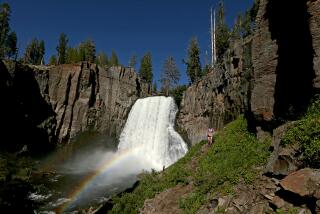The Valley Yesteryear : Margaret Bevis Richter: Her family headed an early real estate syndicate.
- Share via
Margaret Bevis Richter, the daughter and granddaughter of prominent early real estate agents, was 8 years old on that November day in 1913 when Owens Valley water first tumbled down the cascades north of San Fernando.
Lark Ellen, a popular singer, was adorned in purple velvet and ostrich feathers as she sang “I Love You, California” for the hundreds of onlookers, Richter recalled. Everyone had come to picnic, and a festive, anticipatory air prevailed.
William Mulholland was on hand, as the principal builder of the 233-mile aqueduct that brought the mountain water to the arid Southland, across the Mojave Desert through 142 tunnels totaling 52 miles. He told the gathering: “Here it is. Take it.”
And when the water was loosed, the men threw their hats in the air, and laughter and shouts rang out.
“Perhaps he knew better than anyone there that the city and the Valley would never be the same again,” Richter wrote in a family history many years later.
Before the arrival of water, Richter said, Valley ranchers raised cattle and grew wheat. Great combines, pulled by 16- or 32-horse teams across the hot, dry valley, kicked up clouds of dust and chaff. With water, farmers began growing vegetables and beans and fruit, and the price of land went up. In 1913, according to one history, 3,000 acres of land were being irrigated. By 1917, 75,000 acres were getting water.
Margaret’s father, Charles Bevis, and her grandfather, George Albert Lemay, went into the real estate business soon after the family’s arrival from Illinois in 1913, establishing an office at 6320 Van Nuys Blvd. and eventually buying up all the unsold lots in town. For them, the arrival of water was cause for celebration.
Inside of a few years, the town had water, street lights, a streetcar line out from Los Angeles and a newspaper. Charles Bevis was prominent in the growing community. He lobbied for flood control, served on the first school board and the chamber of commerce and crusaded for more parks, playgrounds and trees.
“It was an exciting time to arrive,” Richter remembers. But it wasn’t always easy.
When the Great Depression hit, Bevis and Lemay “had more land than they knew what to do with,” Richter said, and they were nearly wiped out.
More to Read
Sign up for Essential California
The most important California stories and recommendations in your inbox every morning.
You may occasionally receive promotional content from the Los Angeles Times.













